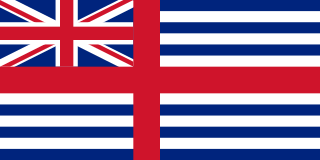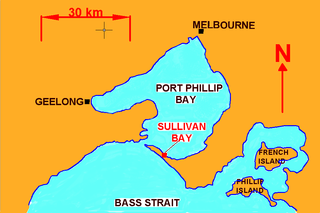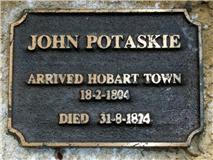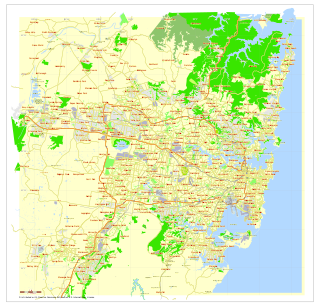
Van Diemen's Land was the original name used by most Europeans for the island of Tasmania, part of Australia. The name was changed from Van Diemen's Land to Tasmania in 1856.
The history of Tasmania begins at the end of the most recent ice age when it is believed that the island was joined to the Australian mainland. Little is known of the human history of the island until the British colonisation in the 19th century.

Colonel William Paterson, FRS was a Scottish soldier, explorer, Lieutenant governor and botanist best known for leading early settlement in Tasmania. The standard author abbreviation Paterson is used to indicate this person as the author when citing a botanical name. In 1795, Paterson gave an order that resulted in the massacre of a number of men, women and children, members of the Bediagal tribe.

Colonel David Collins was a British administrator of Britain's first Australian colonies.

Jørgen Jørgensen was a Danish adventurer during the Age of Revolution. During the Action of 2 March 1808 his ship was captured by the British. In 1809 he sailed to Iceland, declared the country independent from Denmark and pronounced himself its ruler. He intended to found a new republic following the United States and the French First Republic. He was also a prolific writer of letters, papers, pamphlets and newspaper articles covering a wide variety of subjects, and for a period was an associate of the famous botanists Joseph Banks and William Jackson Hooker. He left over a hundred written autographs and drawings, most of which are collected in the British Library. Marcus Clarke referred to Jørgensen as "a singularly accomplished fortune wooer—one of the most interesting human comets recorded in history".

His Majesty's Armed Survey Vessel Lady Nelson was commissioned in 1799 to survey the coast of Australia. At the time large parts of the Australian coast were unmapped and Britain had claimed only part of the continent. The British Government were concerned that, in the event of settlers of another European power becoming established in Australia, any future conflict in Europe would lead to a widening of the conflict into the southern hemisphere to the detriment of the trade that Britain sought to develop. It was against this background that Lady Nelson was chosen to survey and establish sovereignty over strategic parts of the continent.
The modern history of the Australian city of Hobart in Tasmania dates to its foundation as a British colony in 1804. Prior to British settlement, the area had been occupied for at least 8,000 years, but possibly for as long as 35,000 years, by the semi-nomadic Mouheneener tribe, a sub-group of the Nuenonne, or South-East tribe. The descendants of the indigenous Tasmanians now refer to themselves as 'Palawa'.
The following lists events that happened during 1804 in Australia.

Sullivan Bay lies 60 km due south of Melbourne on Port Phillip, one kilometre east of Sorrento, Victoria. It was established as a short-lived convict settlement in 1803 by Lieutenant-Colonel David Collins, who named the bay after the Under-Secretary of State for War and the Colonies, John Sullivan.
Musquito was an Indigenous Australian resistance leader, latterly based in Van Diemen's Land.
The Lieutenant Governor's Court was a court established in the early 19th century in the colony of Van Diemen's Land which subsequently became Tasmania, a state of Australia. The court had jurisdiction to deal with civil disputes where the amount in dispute was not more than £50 sterling in the colony. The establishment of the court was the first practical civil court in the settlement. This was an important first step in improving the resolution of civil disputes in the settlement. The Supreme Court of Van Diemen's Land eventually replaced it in 1823 when the court's charter was revoked by the Third Charter of Justice.
HMCS Integrity was a cutter built by the Colonial Government of New South Wales in 1804. She was the first vessel ever launched from a New South Wales dockyard and carried goods between the colony's coastal settlements of Norfolk Island, Newcastle, New South Wales, Van Diemen's Land and Port Jackson. In 1804 she took part in a series of voyages to Van Diemen's Land with the aim of founding a colony at Port Dalrymple, the site of the modern settlement of George Town, Tasmania.

Joseph Potaski or John Potaskie was the first Pole to settle in Australia, and one of the first convicts to arrive in Van Diemen's Land on Ocean. Joseph Potaski worked hard to establish himself as a successful farmer in colonial Hobart. This was however undone by the exploits of his family. Joseph Potaski reflects the attitudes of those convicts who never progressed beyond their criminal past. Potaski is seen as representing the auspicious beginning of the Polish community in Australia.
Francis was a 41 tons (bm) colonial schooner that was partially constructed at the Deptford Dockyard, England, and sent in frame aboard the Pitt to Australia to be put together for the purposes of exploration. The vessel had originally been designed for George Vancouver’s discovery voyage of the west coast of North America.
Albion was a full rigged whaler built at Deptford, England, and launched in 1798. She made five whaling voyages to the seas around New South Wales and New Zealand. The government chartered her in 1803 to transport stores and cattle, to Risdon Cove on the River Derwent, Tasmania.
Richard Pitt (1765–1826) was an early settler and constable in Tasmania. He migrated to Australia in 1803 on Ocean, one of two ships that founded a short-lived settlement in Port Phillip. The Port Phillip settlement was abandoned in early 1804, and relocated to Hobart. Pitt was made constable in Van Diemen's Land, and in December 1804 was granted 100 acres (40 ha) of land at Stainsforth's Cove. Pitt retained his farming interests, but paid more attention to his official duties as district constable at New Town.
Angela McGowan is an Australian archaeologist known for her work on Aboriginal and European heritage and culture in Tasmania, Australia. McGowan predominantly worked in Heard Island, off the coast of Antarctica and Tasmania, an island off the coast of Australia.





















